Monsoon & Jet Streams | Geography Optional for UPSC PDF Download
Indian Monsoon
- The term 'monsoon' is thought to have originated from the Arabic word for season, 'mawsim'. Monsoons are essentially seasonal winds that change direction based on the season, making them periodic winds. These winds travel from the sea to the land during summers and from land to the sea during winters, creating a dual system of seasonal winds. Some experts consider monsoon winds to be large-scale land and sea breezes.
- Historically, monsoons have been crucial for traders and sailors, who used these winds to travel from one place to another. Though monsoons occur in the Indian subcontinent, central-western Africa, Southeast Asia, and a few other locations, they are most prominent in the Indian subcontinent.
- India experiences southwest monsoon winds during summers and northeast monsoons during winters. The former is caused by the formation of a strong low-pressure system over the Tibetan Plateau, while the latter is due to the high-pressure cells formed over the Siberian and Tibetan plateaus. The southwest monsoons bring heavy rainfall to most parts of India, while the northeast monsoons primarily bring rainfall to the southeastern coast of India, such as the southern coast of Andhra Pradesh and the coast of Tamil Nadu.
- Countries like India, Indonesia, Bangladesh, and Myanmar receive most of their annual rainfall during the southwest monsoon season, whereas southeast China and Japan receive their rainfall during the northeast monsoon season.
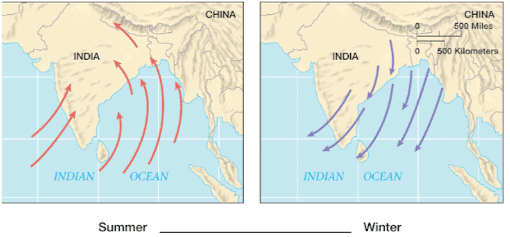
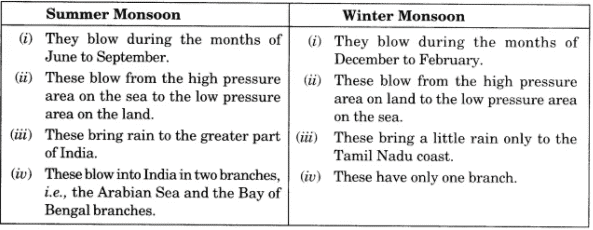
Jet Streams
Jet streams are powerful, fast-moving winds that flow in narrow bands within the upper atmosphere's westerlies. These bands can range from 160-480 km in width and 900-2150 m in thickness, with core speeds surpassing 300 km/hr. Due to their impressive strength, aircraft routes that go against jet stream movements are typically avoided. Jet streams are often found in areas where there are significant breaks in the tropopause.
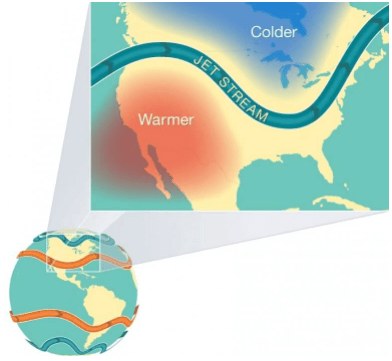
- A jet stream is a geostrophic wind that flows horizontally through the upper levels of the troposphere, typically blowing from west to east. These jet streams form at the boundaries where air masses with different temperatures meet, with surface temperatures usually determining their location.
- The greater the temperature difference between the air masses, the faster the wind velocity within the jet stream. Jet streams extend from latitudes of around 20 degrees to the poles in both the Northern and Southern Hemispheres.
What is Jet Stream?
- Jet streams are narrow, fast-moving bands of air that circle around the Earth's poles in the upper atmosphere. These powerful wind currents are part of the westerly winds and are characterized by their high velocity and meandering patterns.
- They are surrounded by slower-moving winds and play a significant role in shaping weather patterns across the globe.
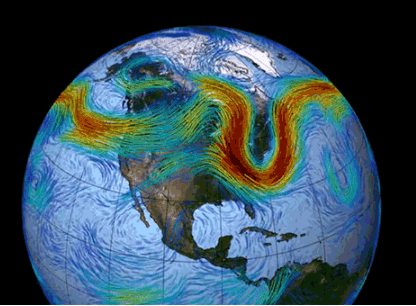
Geostrophic Wind
The geostrophic wind is a theoretical concept that describes the wind's velocity and direction when it is solely influenced by the balance between the Coriolis force and the pressure gradient force. This phenomenon typically occurs in the upper atmosphere, around 2-3 kilometers above the earth's surface, where the frictional effects of the surface are minimal.
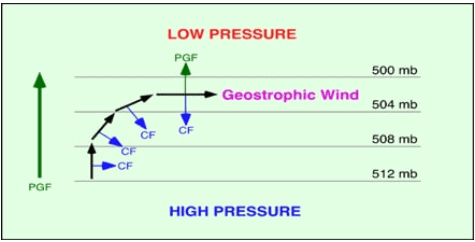 Geostrophic Wind
Geostrophic Wind
- When air parcels start to move from high-pressure areas to low-pressure areas due to the pressure gradient force (PGF), they are deflected by the Coriolis force. In the northern hemisphere, this deflection occurs to the right, while in the southern hemisphere, it occurs to the left. As the wind's speed increases, so does the deflection, until the Coriolis force and the pressure gradient force reach equilibrium.
- At this point, the wind flows parallel to the isobars (the lines connecting points of equal atmospheric pressure) and perpendicular to the pressure gradient force. This specific wind condition, where the forces are balanced, is referred to as the geostrophic wind.

Why winds don’t flow from tropical high pressure (in upper troposphere) to polar low (in upper troposphere) directly as shown in the figure below?

- Geostrophic winds, which flow rapidly due to reduced friction and experience a significant Coriolis force, are responsible for the creation of three distinct atmospheric circulation cells: the Hadley cell, Ferrel cell, and Polar cell.
- Instead of having one large cell, these three smaller cells together generate the same overall effect in distributing heat and driving global atmospheric circulation.
- The presence of these cells can be attributed to the strong deflection caused by the Coriolis force acting on the high-speed geostrophic winds.
Genesis of Jet Streams
The genesis of the Jet-streams is provided by three kinds of gradients:
- The thermal gradient between pole and equator
- The pressure gradient between pole and equator
- The pressure gradient between surface and subsurface air over the poles.
Characteristics of Jet Stream
Jet streams are characterized by their high-velocity winds, which can reach speeds of 400-500 km/h. These impressive speeds are a result of the significant thermal contrasts that create a powerful pressure gradient force.
- These strong winds do not follow a straight path; instead, they meander, encircling the globe in a curved trajectory. The flow of jet streams is three-dimensional, causing crests and troughs to develop along their course.
- In terms of size and dimension, jet streams can span hundreds of kilometers in width and thousands of kilometers in length. Specifically, they typically have a width of 10-12 km, a depth of 2-3 km, and a length of around 3,000 km. Jet streams are found at altitudes just below the tropopause, which is the boundary between the troposphere and stratosphere.
- Jet streams also exhibit seasonal variations, shifting their positions in response to the apparent movement of the sun. They consistently travel from west to east in both the Northern and Southern Hemispheres.
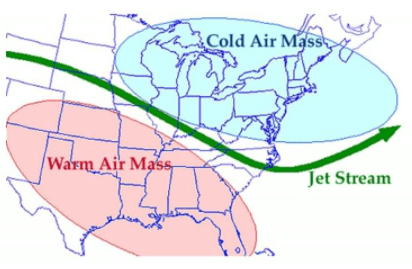 thermal contrast
thermal contrast
Types of jet Streams
- Polar front jet streams
- Subtropical Westerly Jet streams
- Tropical easterly Jet streams
- Polar night Jet Streams
- Local Jet Streams
Permanent jet streams – subtropical jets at lower latitudes and polar front jets at mid latitudes.
Temporary jet streams – Tropical Easterly Jet or African Easterly Jet ,and Somali Jet (southwesterly).
- Polar Front Jet Streams
- Formed above the convergence zone ( 40-60 degree) of surface polar cold air mass and tropical warm air mass
- These move in easterly direction but are irregular
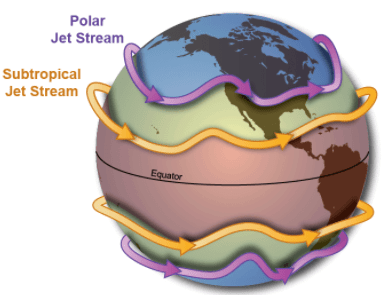
- Subtropical Westerly jet Streams
- Formed above 30-35 latitude
- Move-in upper troposphere to the north of the subtropical surface high-pressure belt
- Also known as stratospheric subpolar jet streams
- Tropical Easterly jet streams
Develop in upper troposphere above surface easterly trade winds over India and Africa during the summer season due to intense heating of Tibetan plateau and play an important role in Indian Monsoon
Polar Night Jet Streams
Develop in winter season due to steep temperature gradient in the stratosphere around the poles
Local Jet Streams
Formed locally due to local thermal and dynamic conditions and have limited local importance.
Index Cycle of Jet Streams
Stage 1
- In subpolar low-pressure belt, the cold air from poles and warm air from subtropics converge along a horizontal line
- Due to the great thermal contrast and differences in the physical properties, they don’t mix up.
- A zone of the stationery situation is created between these 2 air masses
Stage 2
- Cold polar air is pushed by the easterlies and warm air is pushed by westerlies.
- The stationary situation is transformed into an oscillating wave. These are known as Rossby waves
Stage 3
- Cold and warm air further invades each other territory and waves further meander.
- Jet streams of high sinuosity develop and attain maturity
Stage 4
- cold air mass moves into warm air and latitudinal heat exchange occurs.
- The stationary front situation is reattained.
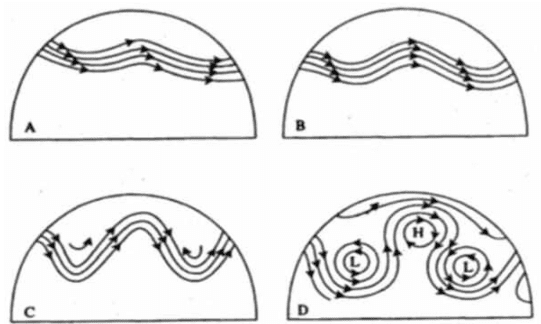 index cycle of Jet stream
index cycle of Jet stream
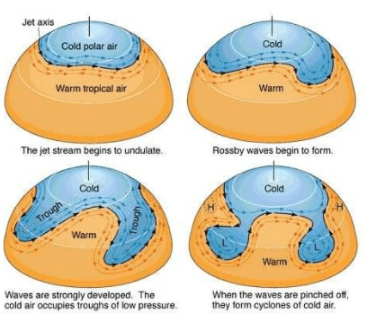
Significance of jet streams
- Jet streams play a significant role in the intensity of mid-latitude cyclones, as these fast-moving air currents in the upper troposphere can amplify the strength and storminess of temperate cyclones when they are positioned above them.
- Additionally, jet streams have a major influence on South Asia's monsoon, as they largely control and impact the weather patterns associated with the monsoon season.
Factors affecting the Jet Stream Flow
- The jet stream flow is influenced primarily by two factors: landmasses and the Coriolis effect. Landmasses interfere with the jet stream's flow due to friction and temperature variations, while the Earth's rotation accentuates these changes. As a result, the jet stream moves across the planet in a meandering pattern, similar to how a river flows before reaching the ocean.
- These winding segments of the jet stream constantly transform as they interact with different landmasses, leading to an ever-evolving flux of temperature variations. During winter, the stratosphere's temperature can also impact the jet stream's strength and position. A colder polar stratosphere results in a more pronounced temperature difference between polar and tropical regions, causing the jet stream to become more powerful.
- Additionally, the warmth of landmasses and oceans, such as the El Niño Southern Oscillation, can influence the jet stream's strength and amplitude. Overall, the jet stream's flow is affected by a combination of factors, including landmasses, the Coriolis effect, and temperature variations.
Jet streams & the weather
- Jet streams have a significant impact on weather patterns as they typically separate colder and warmer air masses. These fast-moving air currents help to move weather systems from one area to another and can even cause them to stall if they have traveled too far.
- Climate experts have found strong links between changes in jet streams and global warming, particularly in relation to the polar jet streams. This is because there is substantial evidence indicating that the North and South poles are warming more rapidly than the rest of the Earth.
- As jet streams become warmer, their fluctuations become more severe, leading to unusual weather patterns in areas that are generally unaccustomed to such variations. For instance, if a jet stream shifts towards the south, it carries the colder air mass along with it. This results in the spread of colder temperatures to regions that typically do not experience such conditions.
Air travel
- Jet streams significantly impact air travel, as they are fast-moving air currents that can affect flight times and safety. When flying eastward, aircraft often experience shorter flight durations due to the assistance of these high-speed winds. However, westbound flights typically take longer as they must travel against the force of the jet streams.
- One of the major threats posed by jet streams to air travel is wind shear, a sudden and violent shift in wind speed and direction.
- This phenomenon can cause planes to unexpectedly lose altitude, increasing the risk of crashing. In response to this danger, the Federal Aviation Administration (FAA) mandated in 1988 that all commercial aircraft be equipped with wind-shear warning systems. However, it took until 1996 for all airlines to fully implement these safety measures on their planes.
Jet Streams affecting the Monsoons and the Indian Sub Continent
- Jet streams, specifically the Subtropical Jet Stream (STJ) and the opposing easterly jet, play a significant role in the monsoon patterns and overall climate of India. The STJ has a considerable impact on the development of summer monsoons.
- As the Indian subcontinent experiences increased solar heating during the approach of summer, a cyclonic monsoon cell tends to form between the Indian Ocean and southern Asia. The development of this cell, however, is hindered by the STJ, which typically blows to the south of the Himalayas.
- During summer, the STJ shifts its course northwards and moves across the Himalayas. Although the jet stream is initially disrupted by the high altitude of the mountains, it reforms over central Asia after crossing the range. With the STJ out of the way, the monsoon cell in the subcontinent rapidly develops, often in just a few days.
- The lower level tropical jet stream supplies warmth and moisture to the monsoon cell, transporting air masses filled with moisture from the Indian Ocean. As these air masses encounter the mountainous terrain of northern India, they are forced upward, causing the air to cool and compress. This process results in the air reaching its saturation vapor point and releasing the excess moisture as monsoon rains.
- The monsoon season comes to an end when the atmosphere over the Tibetan Plateau cools down, allowing the STJ to move back across the Himalayas. This shift leads to the formation of a winter monsoon cell characterized by sinking air masses over India and relatively dry winds blowing towards the sea. Consequently, India experiences more settled and dry weather during the winter months.
Conclusion
Jet streams and monsoons play significant roles in shaping global weather patterns and influencing the climate of various regions. Jet streams are powerful, fast-moving air currents in the upper atmosphere that affect air travel and weather systems, while monsoons are seasonal winds that bring heavy rainfall to countries like India, Indonesia, Bangladesh, and Myanmar. Both phenomena are interconnected and impact each other, particularly in the Indian subcontinent where the jet streams help regulate the monsoon seasons. Understanding these atmospheric processes is crucial for predicting and adapting to changing weather patterns and the effects of climate change.Frequently Asked Questions (FAQs) of Monsoon & Jet Streams
What is the origin of the term 'monsoon,' and how does it affect the Indian subcontinent?
The term 'monsoon' is believed to have originated from the Arabic word for season, 'mawsim.' Monsoons are seasonal winds that change direction based on the season. In India, the southwest monsoon winds bring heavy rainfall during summers, while the northeast monsoon winds bring rainfall primarily to the southeastern coast during winters. These monsoons play a crucial role in India's climate and agriculture.
What is a jet stream, and how does it affect global weather patterns?
Jet streams are narrow, fast-moving bands of air that circle around the Earth's poles in the upper atmosphere. They are part of the westerly winds and are characterized by their high velocity and meandering patterns. Jet streams play a significant role in shaping weather patterns across the globe, as they help move weather systems from one area to another, and can even cause them to stall.
What is geostrophic wind, and how does it relate to jet streams?
Geostrophic wind is a theoretical concept that describes the wind's velocity and direction when it is solely influenced by the balance between the Coriolis force and the pressure gradient force. This phenomenon typically occurs in the upper atmosphere, where the frictional effects of the surface are minimal. Jet streams are a type of geostrophic wind that flows horizontally through the upper levels of the troposphere.
How do jet streams affect air travel?
Jet streams impact air travel significantly, as their high-speed winds can affect flight times and safety. Eastward flights often experience shorter flight durations due to the assistance of jet streams, while westbound flights take longer as they must travel against the force of the jet streams. Wind shear, a sudden and violent shift in wind speed and direction, is a major threat posed by jet streams to air travel, as it can cause planes to unexpectedly lose altitude, increasing the risk of crashing.
How do jet streams influence monsoons and the climate of the Indian subcontinent?
The Subtropical Jet Stream (STJ) plays a significant role in the development of summer monsoons in India. As the STJ shifts its course northwards during summer, it allows the monsoon cell in the subcontinent to rapidly develop, bringing heavy rainfall. The lower level tropical jet stream supplies warmth and moisture to the monsoon cell, resulting in monsoon rains. The monsoon season ends when the STJ moves back across the Himalayas, leading to the formation of a winter monsoon cell and more settled and dry weather during the winter months.
|
304 videos|717 docs|259 tests
|
FAQs on Monsoon & Jet Streams - Geography Optional for UPSC
| 1. What is the Indian Monsoon? |  |
| 2. How does the Indian Monsoon affect agriculture in India? |  |
| 3. What are jet streams and how do they influence the Indian Monsoon? |  |
| 4. What is the cycle of jet streams and how does it affect weather patterns? |  |
| 5. How do jet streams impact aviation and air travel? |  |





















